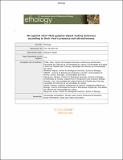Files in this item
Me against who? Male guppies adjust mating behaviour according to their rival’s presence and attractiveness
Item metadata
| dc.contributor.author | Órfão, Inês | |
| dc.contributor.author | Barbosa, Miguel | |
| dc.contributor.author | Ojanguren, Alfredo F. | |
| dc.contributor.author | Vicente, Luis | |
| dc.contributor.author | Varela, Susana | |
| dc.contributor.author | Magurran, Anne E. | |
| dc.date.accessioned | 2020-03-22T00:32:54Z | |
| dc.date.available | 2020-03-22T00:32:54Z | |
| dc.date.issued | 2019-03-22 | |
| dc.identifier | 258371874 | |
| dc.identifier | 766af2db-cc7c-4e1f-ab40-be7e0b36758d | |
| dc.identifier | 85063255962 | |
| dc.identifier | 000467579500008 | |
| dc.identifier.citation | Órfão , I , Barbosa , M , Ojanguren , A F , Vicente , L , Varela , S & Magurran , A E 2019 , ' Me against who? Male guppies adjust mating behaviour according to their rival’s presence and attractiveness ' , Ethology , vol. Early View , pp. 1-10 . https://doi.org/10.1111/eth.12864 | en |
| dc.identifier.issn | 0179-1613 | |
| dc.identifier.other | ORCID: /0000-0002-0036-2795/work/55901218 | |
| dc.identifier.other | ORCID: /0000-0003-0327-9580/work/60630784 | |
| dc.identifier.uri | https://hdl.handle.net/10023/19692 | |
| dc.description | This work was supported by Portuguese National Funds through FCT (Fundação para a Ciência e a Tecnologia), within the cE3c Unit FCT funding (grant number UID/BIA/00329/2013), IO PhD grant (SFRH/BD/90686/2012) and SAMV (SFRH/BPD/66042/2009 and PTDC/BIA‐ANM/0810/14) and MB (SFRH/BPD/82259/2011) Post‐Doctoral research grants. This work was also supported by the ERC (European Research Council) AdG BioTIME (250189) to AEM. | en |
| dc.description.abstract | Sexual selection theory suggests that males need to constantly reappraise their mating decisions to take account of the presence and the phenotypes of their rivals. Here we examine this expectation by asking: (i) If the presence of a rival influences male mating behaviour; (ii) How important is the attractiveness of the rival (absolute attractiveness) in shaping male behaviour; and (iii) How does a male's attractiveness in comparison to his rival (relative attractiveness) influence a male's mating decisions. Using the Trinidadian guppy, a species in which female mate choice (based on males’ attractive traits) plays an important role in male mating outcomes, we recorded the frequency of courtship displays and unsolicited attempts by focal males. First, we quantified focal male mating behaviour with and without a rival. Since the probability of a successful mating is, on average, halved by the presence of a rival, we predicted that under competition the focal male would invest more in less costly mating tactic—unsolicited attempts. Second, we examined how the rival's standard length and area of orange coloration mediated focal male mating behaviour. We found that rival presence influenced how focal males responded to females in terms of both mating tactics. However, the rival attractiveness elicited changes only in male courtship display. Focal males increased courtship display rate if his rival was small or if possessed large amounts of orange, regardless of considering rival absolute or relative attractiveness. Our results show that males invest in the costlier mating tactic when there is no rival or in the presence of a smaller rival. Interestingly, they make a similar investment in the presence of an attractive orange rival. Overall, this study highlights the importance of fine‐grained male decisions in mating encounters and shows that mating tactics are differentially shaped by multiple competition risk cues. | |
| dc.format.extent | 484510 | |
| dc.language.iso | eng | |
| dc.relation.ispartof | Ethology | en |
| dc.subject | Behavioural flexibility | en |
| dc.subject | Body coloration | en |
| dc.subject | Body size | en |
| dc.subject | Female mate choice | en |
| dc.subject | Intrasexual competition | en |
| dc.subject | Social information | en |
| dc.subject | QH301 Biology | en |
| dc.subject | NDAS | en |
| dc.subject.lcc | QH301 | en |
| dc.title | Me against who? Male guppies adjust mating behaviour according to their rival’s presence and attractiveness | en |
| dc.type | Journal article | en |
| dc.contributor.sponsor | European Research Council | en |
| dc.contributor.institution | University of St Andrews. School of Biology | en |
| dc.contributor.institution | University of St Andrews. Centre for Biological Diversity | en |
| dc.contributor.institution | University of St Andrews. Marine Alliance for Science & Technology Scotland | en |
| dc.contributor.institution | University of St Andrews. Institute of Behavioural and Neural Sciences | en |
| dc.contributor.institution | University of St Andrews. St Andrews Sustainability Institute | en |
| dc.contributor.institution | University of St Andrews. Fish Behaviour and Biodiversity Research Group | en |
| dc.contributor.institution | University of St Andrews. Centre for Research into Ecological & Environmental Modelling | en |
| dc.identifier.doi | 10.1111/eth.12864 | |
| dc.description.status | Peer reviewed | en |
| dc.date.embargoedUntil | 2020-03-22 | |
| dc.identifier.grantnumber | 250189 | en |
This item appears in the following Collection(s)
Items in the St Andrews Research Repository are protected by copyright, with all rights reserved, unless otherwise indicated.

